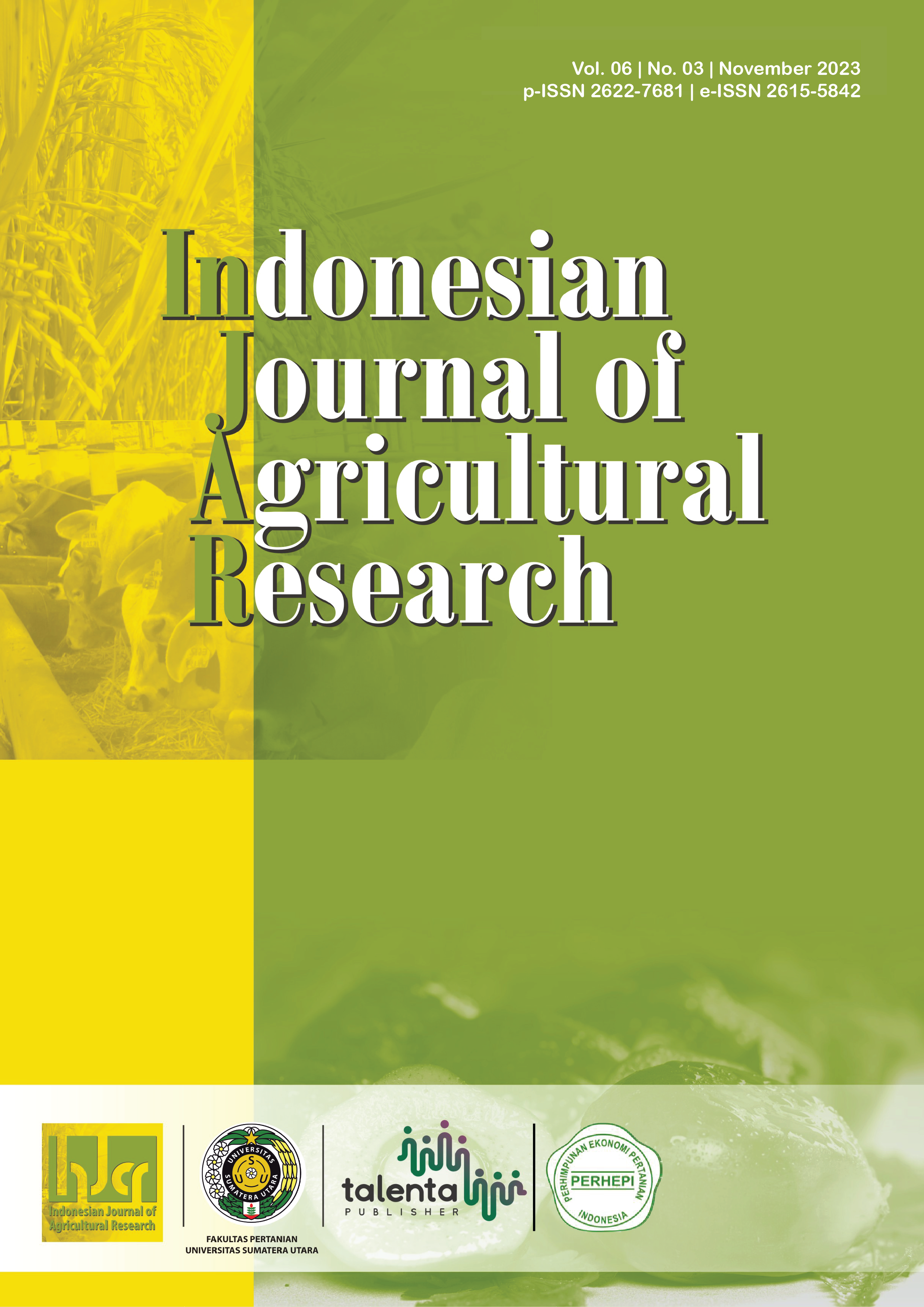Enhancing Small and Medium Scale Enterprises Sustainability: Factors Influencing the Pottery Industry in Sri Lanka
DOI:
https://doi.org/10.32734/injar.v6i3.13473Keywords:
economic factors, environmental factors, pottery industry, small and medium-scale enterprises (SMEs), Sri LankaAbstract
The pottery industry stands as a revered traditional handicraft, bearing both social and economic significance as a sustainable source of revenue within Sri Lanka. This study aims to unravel the elaborate factors that influence small and medium-scale enterprises (SMEs) within this industry. The study targeted small and medium-scale pottery producers in Udukiriwala, Hambantota District of Sri Lanka, with a sample size of 75 participants. The sampling technique employed was a simple random selection method. Data accumulation was coordinated via a precise pre-tested questionnaire, designed to encapsulate demographic particulars and inquiries connect to various constructs using a five-point Likert scale. Comprehensive statistical analysis ensued, encompassing mean calculations, standard deviations, correlation assessments, and regression analyses. Environmental factors exhibit a significant positive correlation, underlining their intense influence on the pottery industry's development. In absolute contrast, economic factors showcase a notable negative correlation. Meanwhile, sociological factors and government influence factors exhibit no statistically significant correlations with the pottery industry's evolution. The recognition of pivotal factors shaping the pottery industry sets the stage for well-informed actions, providing a solid basis for fostering its sustained expansion and advancement within the Sri Lankan context.
Downloads
References
D. D. F. Del Rio, B. K. Sovacool, A. M. Foley, S. Griffiths, M. Bazilian, J. Kim, and D. Rooney, “Decarbonizing the ceramics industry: A systematic and critical review of policy options, developments and sociotechnical systems,†Renewable and Sustainable Energy Reviews, vol. 157, p. 1-31, 2022.
IndexBox, “Sri Lanka’s Clay Market Report 2023 - Prices, Size, Forecast, and Companies,†[Online]. Available: https://www.indexbox.io/store/sri-lanka-clays-market-analysis-forecast-size-trends-and-insights/. Accessed: Aug. 28, 2023.
W. E. Dahanayake, “Sustainability of Small and Medium Enterprises in Sri Lanka: impact of economic crisis,†in Proc. International Conference on Business Research University of Moratuwa, Sri Lanka, 2022, pp. 218-234.
E. M. S. Ekanayake, R. P. I. R. Prasanna, J. M. S. B. Jayasundara, S. K. N. Gamage, P. S. K. Rajapakshe, G. A. K. N. J. Abeyrathne, and K. A. K. I. C. Gunasena, “Traditional SMEs with cultural heritage: challenges in modernity a case study from Sri Lanka,†International Journal of Arts and Commerce, vol. 9, no. 11, pp. 76-95, 2020.
S. Arunashantha and S. M. R. S. Bandara, “The environmental impact of the clay industry in Sri Lanka: with special reference to Dankotuwa Divisional Secretariat Division (DSD),†International Journal of Scientific and Research Publications, vol. 10, no. 7, pp. 92-96, 2020.
L. Smith, “Processing clay for pottery in Northern Cameroon: social and technical requirements,†Archaeometry, vol. 42, no. 1, pp. 21–42, Feb. 2000, doi: https://doi.org/10.1111/j.1475-4754.2000.tb00864.x.
A. Hein and V. Kilikoglou, “Ceramic raw materials: how to recognize them and locate the supply basins: chemistry,†Archaeological and Anthropological Sciences, vol. 12, no. 8, Jul. 2020, doi: https://doi.org/10.1007/s12520-020-01129-8.
M. Yu, S. M. Tariq, and H. Yang, “Engineering clay minerals to manage the functions of soils,†Clay Minerals, vol. 57, no. 1, pp. 51–69, Mar. 2022, doi: https://doi.org/10.1180/clm.2022.19.
L. Zhou, X. Zou, Y. Huang, Y. Li, L. Guo, and J. Fu, “Inheritance and Innovation of Pottery Sculpture Technique in Shiwan, China: A Grounded Study from Cultural Ecology,†International Journal of Environmental Research and Public Health, vol. 20, no. 4, p. 3344, Feb. 2023, doi: https://doi.org/10.3390/ijerph20043344.
M. Aliyev, “Somut olmayan kültürel miras seramik ve çini sanati,†Eurasian Academy of Sciences Social Sciences Journal, no. 44, Dec. 2022, doi: https://doi.org/10.17740/eas.soc.2022.v44-02.
D. O. Reis, “Traditional (art)craft: frictions between thought matrices,†Etnográfica, no. vol. 26 (1), pp. 209–231, Feb. 2022, doi: https://doi.org/10.4000/etnografica.11464.
J. Birmingham, “Traditional Potters of the Kathmandu Valley: An Ethnoarchaeological Study,†Man, vol. 10, no. 3, p. 370, Sep. 1975, doi: https://doi.org/10.2307/2799808.
M. Horakova, “Consumer behavior of college students in the Czech Republic,†Journal of Competitiveness, vol. 7, no. 4, pp. 68–85, Dec. 2015, doi: https://doi.org/10.7441/joc.2015.04.05.
D. Winslow, “Pottery, Progress, and Structural Adjustments in a Sri Lankan Village,†Economic Development and Cultural Change, vol. 44, no. 4, pp. 701–733, Jul. 1996, doi: https://doi.org/10.1086/452242.
M. Ãngel, G. Montana, Evanthia Tsantini, and L. Randazzo, “Ceramic Ethnoarchaeometry in Western Sardinia: Production of Cooking Ware at Pabillonis,†Archaeometry, vol. 57, no. 3, pp. 453–475, Apr. 2014, doi: https://doi.org/10.1111/arcm.12100.
S. Ghazinoory, A. Sarkissian, M. Farhanchi, and F. Saghafi, “Renewing a dysfunctional innovation ecosystem: The case of the Lalejin ceramics and pottery,†Technovation, vol. 96–97, p. 102122, Aug. 2020, doi: https://doi.org/10.1016/j.technovation.2020.102122.
A. Toledo, J. de la P. Hernández, and D. Griffin, “Incentives and the growth of Oaxacan subsistence businesses,†Journal of Business Research, vol. 63, no. 6, pp. 630–638, Jun. 2010, doi: https://doi.org/10.1016/j.jbusres.2009.03.021.
L. U. Wei, “On the Creative Economics and the Development of Creative Industries: with the Creative Cultural Industry of Jiangxi Jingdezhen Ceramics as an Example,†Journal of Jiangxi University of Finance and Economics, vol. 0, no. 06, p. 615, Jan. 2021. [Online]. Available: http://cfejxufe.magtech.com.cn/xb/EN/Y2012/V0/I06/615. Accessed: Jan. 04, 2024.
Travakol, M. and Dennick, R. 2011. Marking sense of Cronbach’s alpha: University of Nottingham; medical education unit .UK.
Pallant J. 2013. SPSS Survival Manual: Rural Health. University of Tasmania; Launceston Tasmania. Australia.
N. Wuryaningrum, S. Sabihaini, and D. Yudhiantoro, “The Effect of environment complexity and resources on the performance of SMEs mediated by business strategy (survey on Kasongan Pottery SMEs in Bantul Regency),†Jurnal Penelitian Ekonomi dan Bisnis, vol. 7, no. 1, pp. 35–45, Mar. 2022, doi: https://doi.org/10.33633/jpeb.v7i1.4257.
K. V. A. H. P. Wijenayake, “Development through Industrialization: A Literature Review of Policies and Issues in Sri Lankan Industrial Sector,†South Asian Journal of Social Studies and Economics, pp. 38–67, Sep. 2021, doi: https://doi.org/10.9734/sajsse/2021/v12i330307.
Downloads
Published
How to Cite
Issue
Section
License
Copyright (c) 2024 Indonesian Journal of Agricultural Research

This work is licensed under a Creative Commons Attribution-NonCommercial-ShareAlike 4.0 International License.



















